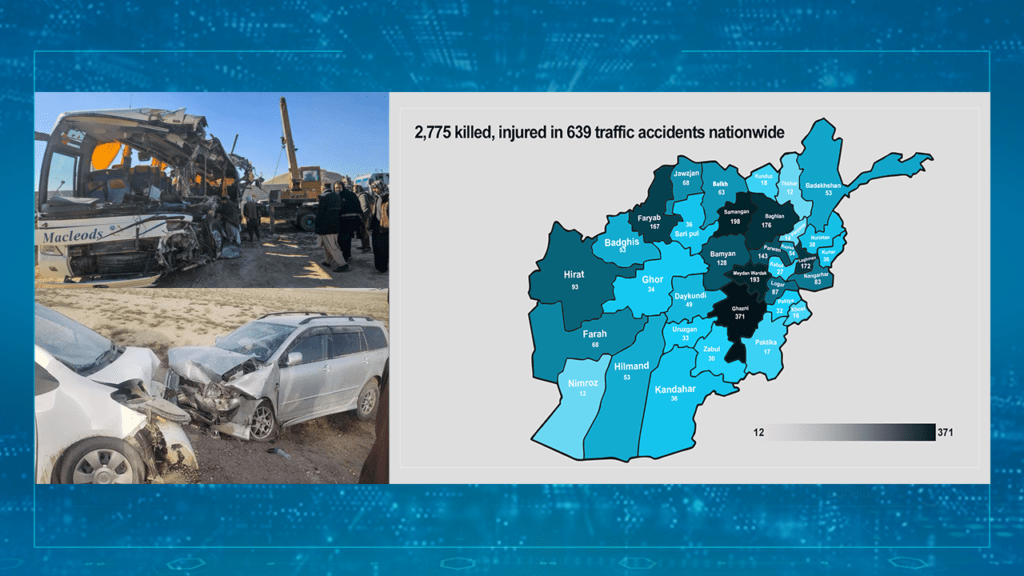KABUL (Pajhwok): Nearly 770 people have been killed and 2,008 others wounded in 639 traffic accidents in the first 10 months of the ongoing solar year nationwide, Pajhwok Afghan News has leaned.
Figures, however, showed 32 percent drop in casualties in the past five months now compared to the past.
More than half of these deaths and injuries occurred in Ghazni, Samangan, Maidan Wardak, Baghlan, Laghman, Faryab, and Badakhshan provinces, with the highest number of deaths and injuries occurring on December 29; on that day, 50 people were killed and 70 others injured in two incidents in Ghazni, and five people were killed and injured in Parwan.

Figures recorded with Pajhwok showed that 68 percent of all fatalities and injuries are adult males, eight percent are females, eight percent are children, and 16 percent are persons of unknown gender. According to previous Pajhwok reports, the reason for the higher number of fatalities and injuries among men in traffic accidents is that they travel more than children and women.
Similarly, Pajhwok Afghan News’ findings showed that the highest number of people killed in Ghazni, Badakhshan, Baghlan, and Faryab, while the highest number of people were injured in Ghazni, Maidan Wardak, Samangan, and Laghman provinces.
The death toll could be higher because this figure is only for the 639 traffic accidents that Pajhwok Afghan News Agency has reported; Pajhwok did not report traffic accidents in which no one is killed or fewer than five people got injured.
91 people killed, 280 injured in Ghazni, 78 killed, 87 injured in Badakhshan, 66 killed, 110 injured in Baghlan, 58 killed, 109 injured in Faryab, 43 killed, 155 injured in Samangan, 42 killed, 51 injured in Herat, 37 killed, 156 injured in Maidan Wardak, 32 killed, 140 injured in Laghman, 28 killed, 115 injured in Parwan, 26 killed, 57 injured in Nangarhar, 25 killed, 103 injured in Bamyan, 24 killed, 39 injured in Balkh, 22 killed, 31 injured in Helmand, 20 killed, 48 injured in Farah, 15 killed, 34 injured in Daikundi, and 15 killed, 39 injured in Kapisa.
Similarly, 14 killed, 54 injured in Jawzjan, 14 killed, 24 injured in Nuristan, 14 killed, 19 injured in Uruzgan, 12 killed, 22 injured in Ghor, 12 killed, 75 injured in Logar, 12 killed, 24 injured in Sar-e-Pul, 10 killed, 43 injured in Badghis, 8 killed, 19 injured in Kabul, 8 killed, 6 injured in Panjshir, six killed, 30 injured in Kandahar, six killed, 30 injured in Kunar, five killed, 11 injured in Khost, five killed, 27 injured in Paktia, five killed, 25 injured in Zabul, four killed, 14 injured in Kunduz, four killed, 13 injured in Paktika, three killed, nine injured in Nimroz, and three killed and nine injured in Takhar.
Traffic accident statistics recorded by Pajhwok show that the number of fatalities and injuries due to traffic accidents has decreased by nearly 32 percent compared to the first five months of the current solar year.
In the first five months, 1,648 people were killed and injured in 458 traffic accidents, and in the last five months, 1,127 people were killed and injured in 181 traffic accidents.
According to the findings, the number of traffic accidents in the first five months of this year was high because there were two Eids during this period and many traffic accidents occurred during the previous Eid-ul-Fitr and Eid-ul-Adha.
Reasons behind traffic accidents and solutions
Wahidullah, a resident of Kunar’s Asmar district was injured in the Ghazni traffic accident said: “I was going to Kandahar, I bought a ticket in Kabul, I was on my way out when suddenly this accident happened, the vehicle was also driven in a high speed. My request to drivers is that this road is not a one-way road, they should be very careful.” Farzad Akbari, a resident of Mazar-i-Sharif’s seventh Police District, said: “About eight months ago, his cousin lost his life in a traffic accident, saying it was a very painful event.”
He called on drivers and said: “My dearest cousin lost his life in a traffic accident. It is a very painful thing. However, I urge all drivers to not drive too fast and to be careful.”
Akbari also called on the government to prevent these incidents, as traffic accidents have increased in recent days.
Khalifa Raosul, a resident of western Herat province, said around one month before six people were killed in a traffic accident and around 16 people, including their relatives, were injured.
He said: “The government should hold a meeting with companies to control vehicle speed; because this [Kabul-Herat] highway is a public road and connects one province to another; there is a lot of traffic on it and drivers should be careful.”
Mohammad Nabi Afghan, Deputy Chairman of the Land Transport Coordination Council, told Pajhwok Afghan News unfortunately many traffic accident happens on highways and it has different factors.
He said the construction of substandard and poor roads, the presence of large boulders on highways, the movement of vehicles on both sides of the highway, lack of weight control, the lack of specialized personnel in the construction and design of highways, the presence of substandard policies in the transportation sector, the presence and increase of vehicles that violate Afghanistan’s traffic laws, the conflict of policies, plans, and plans of transport-related agencies, the lack of coordination between traffic and transportation agency officials, forcing drivers to drive for more than eight hours, and some other factors are some of the factors that cause many traffic accidents on highways.
He asked on government to take action in this regard and added: “The causes of traffic accidents are different, but most of them are attributed to the government, we have talked a lot and discussed it repeatedly over the past two to three years since the takeover of the IEA, and I have also spent a lot of resources on these issues.”
Mohammad Nabi said: “Roads should be built according to load; the design and structure of the road are from the time of Zahir Shah, there is a large volume of traffic on it, four to five thousand vehicles travel on it every day, and right-hand traffic is allowed to pass freely”.
Referring to the recent decline in traffic accidents, he said: “There has been a slight decrease, there is more and more control, checkpoints have been set up, but roads need to be built, control has been established and people have become aware.”
He said that there are also problems among drivers, and transport companies also have their own problems and mistakes that they must pay attention to and prevent.
Col. Abdul Wadud Khairkhawa, told Pajhwok Afghan News that unfortunately more traffic accidents happens and people’s lives are lost.
Referring to the casualty figures caused by traffic accidents, he said; “The numbers you get from health centers are accurate because all victims are registered there and are relatively accurate, but your statistics are lower for traffic accidents, more than a thousand cases have been registered, the deaths are accurate, and the number of injuries may be three percent higher than your figures.”
The poor quality of roads and bridges, obvious and hidden technical problems and malfunctions of vehicles, carelessness and unprofessionalism of drivers, negligence of transport companies, and the hiring of inexperienced people by these companies are the causes of traffic accidents on highways, said Khairkhawa.
Referring to the traffic control and the prevention of traffic accidents, he said: “Traffic flow should always be under control; fortunately, we have this plan, we send the plans to the relevant managements and it is already working, it is the efforts of this administration that these incidents are rare… Our roads are under control, our traffic police are working actively, and the traffic administration keeps everything under control by creating sound policies and sending them to the relevant managements, and we strived to prevent traffic accidents from occurring on the highways.”
He also believed that lack of coordination and conflicting policies between traffic and transportation agencies were the causes of traffic accidents, but added that this problem has been addressed in the newly developed plan of this agency, and with its implementation, this shortcoming would be eliminated.
nh








GET IN TOUCH
NEWSLETTER
SUGGEST A STORY
PAJHWOK MOBILE APP